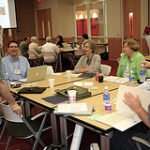NMC Releases Horizon Report: 2009 Australia-New Zealand Edition | nmc
 As usual the Horizon report is fairly well grounded in the state of play.
As usual the Horizon report is fairly well grounded in the state of play.
The Horizon Report: 2009 Australia-New Zealand Edition (1.3 MB, 32 pp) is available now. The report is free, and has been released with a Creative Commons license to facilitate its use, easy duplication, and broad distribution.
A few of the elements that stand out for me (especially in the light of Mantz Yorke’s presentation earlier today)
- “The ways we design learning experiences must reflect the growing importance of innovation and creativity as professional skills [capabilities??/attributes??] if students are to succeed beyond the classroom”
- “It provides virtual spaces where people who share interests can congregate; it facilitates serendipitous connections between people located in very different parts of the world…”
- “Technology is increasingly a means for empowering student, a method for communication and socialising, and a ubiquitous, transparent part of their lives.” (Yet, some academics label it a disruptive force)
- “..the learning environment is no longer limited to a physical space…institutions must reflect and support the transformation of the learning environment by embracing the means that make it possible…”
It also addresses some implications if these changes do occur:
- Evaluation and assessment (as Mantz also suggested)
- Physical infrastructure in learning institutions – aged facilities may not support contemporary practices.
- new skills [attributes??] explicitly addressed in instructional strategies.
- technology engagement must become vernacular in educational settings – no longer a novelty.
Technology barometer (Time-to-adoption)
- Mobile Internet Devices (1 year or less to mainstream adoption)
- Private Clouds (1 year or less to mainstream adoption)
- Open Content (2-3 years to mainstream adoption)
- Virtual, Augmented and Alternate Realities (2-3 years to mainstream adoption)
- Location-based learning
- Smart objects and devices (as simple as QR coding through to embedded chips) (4-5 years to mainstream adoption)
While we are making some inroads in to these areas, could it be argued that the timeframes for mainstream adoption are also running in advance of our staff development and resource provision?
The report contains links to really engaging examples of sites where changes are already occurring, as well as some useful links to more detailed information about the issues and technologies raised.
![Reblog this post [with Zemanta]](http://img.zemanta.com/reblog_a.png?x-id=1bfccba4-e360-83be-8040-2e628a2c92c5)





